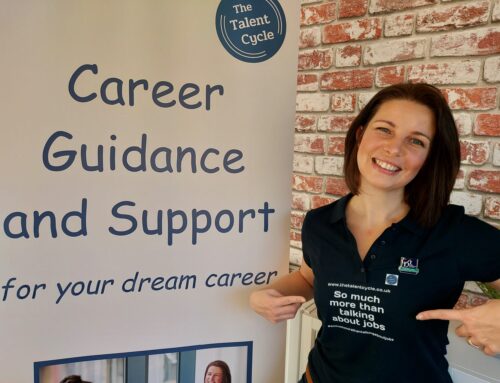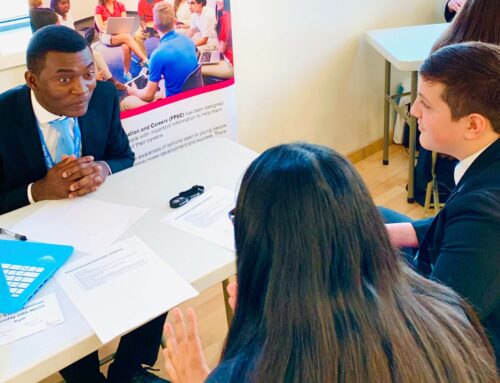In recent years, a number of research studies have established that many female students, even the most capable ones, never seriously consider the possibility of a STEM career…
Taken from STEM Careers by Paul Greer.

In fairness, we need to qualify this a little. First, the entry statistics in life sciences are quite healthy, as biology is a popular subject among female students at A level and beyond, and even the majority of entrants to British medical degree courses are now women. Second, often after gaining maths-related degrees, many women have become well-established professionally in the financial world, including qualifying as accountants, and are able to use their mathematical skills successfully. However, these facts shouldn’t disguise that many female students are at least hesitant and frequently reluctant to explore the opportunities within the physical sciences, technology and engineering – in effect, a very wide spectrum of jobs.
To illustrate just a couple of the careers out there, three women share what their roles in STEM involve:
I work for an engineering firm which manufactures items used in industry. I make the final drawings which the production-line staff refer to. There are actually two stages in the drawing process; the first is known as ‘design’, which entails producing a scale drawing presenting the general outline, plus a calculation of the number of parts needed, together with their size and weight. The second stage is called the ‘detail’, which is what I and three of my colleagues do.
The detail stage requires a separate drawing for each part of the manufacturing procedure. Each one in the series has to be very precise, but easy to understand, as the production-line staff rely on it alone. I have to know what machinery they’ll be using, and what its capabilities are, as well as the skill levels of the staff themselves. I actually spend a lot of time on the shop floor to find out what I need to know, which includes talking to the operations people. Care and accuracy, and attention to detail are all really important, or you may miss something vital. You must be able to use mathematical formulae and be happy using a calculator. We use CAD technology for the drawings themselves, although the ability to do a quick hand sketch can still sometimes come in handy.
Six of us belong to the drawing team, including Sharon, whom I was at college with. We both took design and technology to NVQ level 2, but wanted a job with a really practical side, as well. We applied for an apprenticeship here and were really surprised when we were both taken on. The training was first-rate, but not easy in the beginning – often having to put in some study following what seemed a long day (after college) – but it was all really interesting. About a year after finishing the apprenticeship, I asked to go part-time, so I work 25 hours a week, rather than 35. This lets me leave early each day, which is really helpful, as my partner works full-time and our little boy’s only two.
Engineering is still a predominantly male occupation, but Sharon and I have never felt put down by any of the men here and really feel we’re valued as much as anyone else. I’ve no plans to move on, but if I did, I’d still want to be in engineering.
Laura, engineering draughtsperson
My specialist field is endangered species and I work mainly in zoos and safari parks. When I do fieldwork, it’s normally in Africa, though quite recently I contributed to a project on bears, which entailed trips to North America and China. People like me have to look not only at an animal’s physiology and behaviour, but its environment, too. When a species becomes endangered, or even extinct, it’s hardly ever explained by only a single reason or factor, but rather a combination, which often includes destruction of habitat through such processes as deforestation by logging companies, encroachment on living space by humans, and the introduction of inimical foreign species.
The initial task of a fieldwork expedition is normally to record the range of species within a precise geographical area, usually a fairly small one. This contributes to forming a picture reflecting the locality, but which raises understanding at national and global levels, too. The next step entails minute observation of specific animals, and technology now lets us gather far more data than ever, with miniature cameras and microphones recording every movement and sound. This has contributed enormously to seeing how certain species raise their young. These facilities don’t tell us everything, though, and you still have to get close up, which takes patience, as animals are very sensitive and easily spooked.
Observations made in the field aid the survival of the indigenous species, but also improve our understanding and treatment of animals in captivity, which is where my contact with zoos and safari parks comes in. As well as discussing particular species with established staff there, I help to train newcomers and do a limited number of talks to the visiting public. These (I hope) help people better to understand and enjoy the animals they see there, but also grasp that the ‘wow factor’ animals often depend on less spectacular ones and so their well-being is important too.
My remaining time is usually university- or research centre-based. This is where we analyse recordings and do the number-crunching. You need to be good with figures, because statistics form the basis of published research, but also because reliable numbers can drive positive action, including government policy. The laboratory work I do relates to selection and breeding and an exciting area is the reintroduction of species from captivity into the wild – but this has to be really well thought through, and relies on co-operation from all quarters.
I did my first degree in ecology, followed by a PhD in zoology. The work is demanding and involves a lot of travel, but I’ve had some wonderful encounters with very special animals. I’ve no wish to be doing anything else.
Sunita, zoological scientist
I teach biology at a secondary school with a sixth form. Most of my work is with final-year GCSE and A level students. I spend part of each day planning lessons, and making sure any equipment I need for laboratory lessons is available and in good order. You have to give very specific directions to students doing lab work for health and safety reasons – fortunately, biology tends not to be quite as hazardous as chemistry!
Students submit a lot of their work on computer, which means it’s easy to mark at home if I haven’t time during the school day. I offer as much feedback as I can on a one- to- one basis, especially to my A level students, and particularly if I feel they haven’t quite grasped something which I know will also be important later in the syllabus; having said that, it’s not always easy to judge whether someone has really understood a concept. Biology is the most popular science by some way among our female students, so the A level group is well balanced gender- wise. This makes it easier to get girls to take seriously the prospect of a career in biology, especially once they’ve had a university visit.
I like teaching project work on specific topics, which are good for showing the relevance of biology as a subject. Some, like global warming, make it easy to demonstrate how things are interlinked and how collective small changes can lead to major upheavals. I accompany students on at least one field trip each year; the last two have been to a nature reserve near the coast, which offers a good range of flora and fauna. The trips are really useful for getting students to work together and to see how different specialisms can combine to produce useful findings, or an overall picture.
The school has two open evenings each year, which offer chances to attract would-be science sixth-formers, as we’re the only one of three local secondary schools offering A levels.
I’ve been here 12 years and have no ambition to be a head of department or an administrator. I’m an Advanced Skills Teacher and am quite content, salary-wise. It might be nice to be ranked as an Excellent Teacher, but it’s not something I’m pushing for. Feeling that I’ve helped a student towards a real interest in the subject I love is the biggest satisfaction.
Angela, biology teacher
If you’re good at STEM subjects, or feel enthusiastic about a related career, you shouldn’t be denied the chance to progress as far as you want with it. So don’t be beaten before you’ve begun, and remember that everyone is likely to be on your side, too.

Emma Davies works within the editorial department at Trotman Publishing. Graduating from her Masters degree in 2017, she is familiar with all aspects of the student journey through university. She is passionate about helping students find the right career, and was a member of the SYP’s inaugural committee in the South West.






